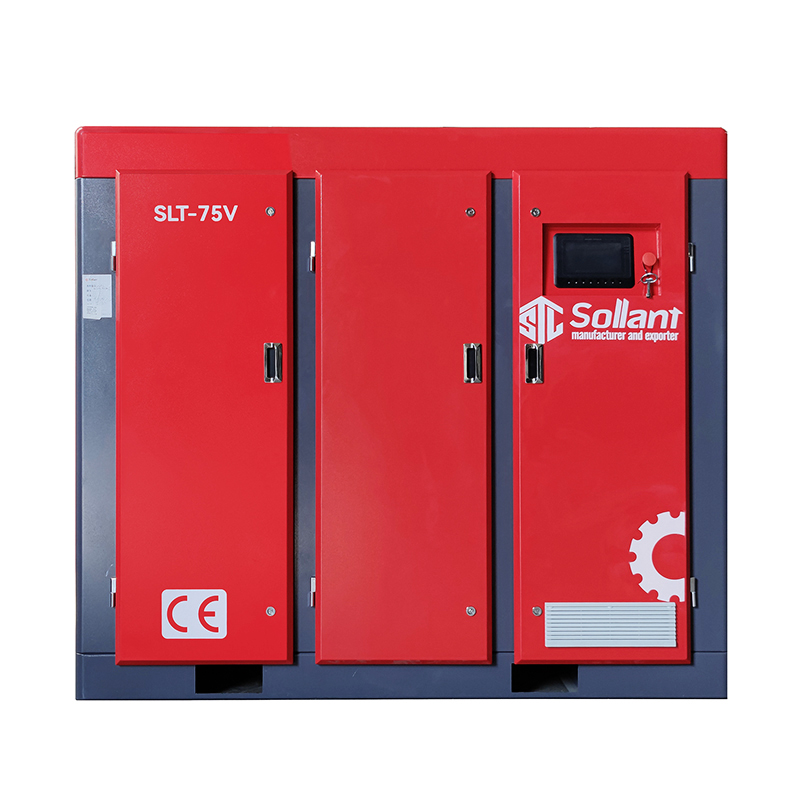
Screw air compressors are indispensable in a wide range of industries, providing compressed air to power machinery, tools, and manufacturing processes. However, as essential as they are, they can also account for a significant portion of energy consumption in many operations. With rising energy costs and increasing pressure to minimize environmental impact, optimizing the energy efficiency of screw air compressors is not just beneficial—it’s essential.
This article will provide actionable energy-saving tips that can help reduce the operating costs associated with screw air compressors, improve efficiency, and enhance the longevity of the equipment.
1. Regular Maintenance and Servicing
Regular maintenance is the foundation of any energy-efficient system, and screw air compressors are no exception. A well-maintained compressor runs more efficiently, consumes less energy, and lasts longer.
Preventive Maintenance:
Routine tasks like checking oil levels, lubricating moving parts, and inspecting belts and valves can significantly impact compressor performance. A compressor with worn-out parts or improper lubrication will need to work harder to achieve the desired output, thus consuming more energy.
Air Leakage Detection and Repair:
Air leakage is one of the most common reasons for energy inefficiency in compressed air systems. Even a small leak can lead to significant energy losses. Conducting regular leak audits and using leak detection methods (such as ultrasonic detectors) can help identify problem areas. Sealing leaks as soon as they are detected can prevent unnecessary air loss and reduce compressor runtime.
Clean and Replace Filters:
Air filters play a crucial role in maintaining airflow and preventing contaminants from entering the system. Over time, filters can clog, causing the compressor to work harder to push air through. Regularly cleaning or replacing filters can ensure smooth airflow, reducing the strain on the compressor and improving energy efficiency.
2. Implementing Variable Speed Drive (VSD) Technology
Variable Speed Drive (VSD) technology is one of the most effective ways to improve energy efficiency in screw air compressors.
What is VSD?
VSD compressors are designed to adjust their speed based on real-time demand for compressed air. Instead of running at a constant speed, a VSD compressor will slow down or speed up depending on the air required by the system, resulting in significant energy savings.
Benefits of VSD:
- Reduced Energy Consumption: VSD technology ensures the compressor operates only when necessary, avoiding the energy waste associated with running the compressor at full capacity all the time.
- Lower Operating Costs: Although the initial investment for a VSD compressor is higher than a fixed-speed model, the long-term savings on energy consumption make it a cost-effective option for many operations.
When to Use VSD:
VSD compressors are particularly beneficial in operations with fluctuating air demands, such as manufacturing facilities with varying work shifts or industries that experience peaks and troughs in air demand. For steady, continuous air demand, a fixed-speed compressor might still be suitable.
3. Optimize Air Pressure Settings
Operating at the correct pressure is crucial for energy efficiency in screw air compressors. Many compressors are set to a higher pressure than needed, leading to unnecessary energy consumption.
Set Pressure to the Right Level:
Each application has an optimal pressure range. Operating a compressor at a higher pressure than required not only wastes energy but also shortens the lifespan of the equipment. Make sure to adjust the pressure settings according to the specific needs of your operation.
Pressure Bandwidth Optimization:
Pressure should be maintained within a narrow range to avoid over-pressurization and under-pressurization. Tightening the pressure band can reduce the energy used during operation. Additionally, monitoring the pressure consistently will ensure that the system operates efficiently without wasting power.
4. Reduce Operating Time with Smart Control Systems
The introduction of automated control systems in screw air compressors has been a game-changer in improving energy efficiency.
Automated Shutdown/Start-Up Systems:
Many modern screw air compressors are equipped with automated systems that detect when the demand for compressed air has stopped or significantly decreased. These systems automatically shut the compressor down during idle periods, preventing energy waste.
Load/Unload Control:
In traditional compressors, when the system reaches the preset pressure, the compressor goes into an idle or “unload” mode. This cycling between load and unload modes can be optimized to reduce energy consumption. By improving the load/unload control process, compressors can operate more efficiently, only consuming energy when required.
5. Use Efficient Air Drying and Filtration Systems
Air dryers and filtration systems are often integral parts of air compressor setups. Using inefficient dryers or filters can increase the overall energy consumption of the compressor.
Proper Drying and Filtration:
Compressed air must often be dried to prevent moisture from damaging tools and machinery. However, inefficient air dryers can use a lot of energy. Switching to energy-efficient dryers, such as heatless or heat-regenerated dryers, can reduce energy use. Choosing the right type of dryer based on your application can help minimize energy waste.
Correct Sizing of Dryers and Filters:
Choosing the correctly sized dryer or filter for your system is crucial. Oversized systems can consume more energy than necessary, while undersized systems will force the compressor to work harder to maintain the correct air quality or pressure.
6. Improve System Design and Air Distribution
The design of the entire compressed air system, including the piping and distribution, plays a significant role in energy efficiency.
Right-Sized Air Compressors:
Selecting the right compressor size is essential. An oversized compressor will cycle on and off frequently, using more energy than necessary. Conversely, an undersized compressor will have to run continuously at full capacity, also wasting energy. Proper sizing based on actual demand can improve energy efficiency and reduce wear and tear on the system.
Optimizing Pipework and Distribution:
The design of the air distribution system can also impact energy usage. Ensure that your pipes are properly sized and as short and straight as possible to minimize frictional losses. Insulating the pipes, especially in colder environments, can prevent heat loss and reduce energy consumption.
7. Load Matching with Application Demand
Matching the compressor’s load to the application’s demand is another important strategy for reducing energy consumption.
Demand Matching:
One of the primary causes of energy waste in screw air compressors is the mismatch between the system’s demand and the compressor’s output. It’s essential to adjust the compressor size and output to match the air demand of your operation. This avoids running a large compressor when a smaller one would suffice, leading to lower energy consumption.
Using Multiple Smaller Compressors:
For operations with variable or fluctuating air demand, using multiple smaller compressors instead of one large one can result in better efficiency. Smaller compressors can be turned on and off as needed, ensuring that only the required amount of air is being produced at any given time.
8. Utilize Heat Recovery Systems
Many compressors generate significant amounts of waste heat during operation. This heat can be recovered and repurposed, providing a valuable energy-saving opportunity.
Heat Recovery for Water Heating:
By installing a heat recovery system, waste heat from the compressor can be used to heat water for other processes, such as cleaning or heating water for industrial use. This reduces the need for external heating sources, cutting energy costs.
Implementing a Heat Recovery System:
While there is an initial investment in setting up a heat recovery system, the long-term energy savings make it a worthwhile investment for many industrial applications.
9. Monitor Energy Consumption and Performance
Tracking energy consumption and performance is essential to identify inefficiencies and take corrective action.
Energy Monitoring Systems:
Implementing energy monitoring systems allows you to track the real-time energy consumption of your compressors. These systems can provide detailed data on compressor performance, enabling you to identify inefficiencies, adjust operational settings, and make informed decisions about upgrades or maintenance.
Regular Performance Audits:
Conducting performance audits periodically can help detect areas where energy is being wasted. Regular audits allow you to optimize your system further and ensure that all components are functioning as efficiently as possible.
10. Training and Employee Awareness
Employees play a crucial role in ensuring the energy efficiency of the compressor system.
Training Staff on Best Practices:
Educating staff about the importance of energy efficiency and the best practices for operating compressors can lead to significant energy savings. Simple actions like turning off equipment when not in use or reporting maintenance issues promptly can reduce energy waste.
Raising Awareness of Energy Costs:
When employees understand the impact of energy usage on the company’s bottom line, they are more likely to adopt energy-saving habits. Regularly remind your team of the benefits of energy efficiency and how they contribute to reducing overall costs.
Conclusion
Reducing energy consumption in screw air compressors is not only about selecting the most efficient compressor but also about optimizing the system’s design, usage, and maintenance. By following these energy-saving tips—ranging from regular maintenance and proper pressure settings to implementing advanced technologies like VSD and heat recovery systems—you can significantly reduce energy costs, increase the lifespan of your equipment, and contribute to a more sustainable operation.


